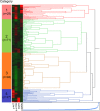Profiling of phospho-AKT, phospho-mTOR, phospho-MAPK and EGFR in non-small cell lung cancer
- PMID: 24487999
- PMCID: PMC4005365
- DOI: 10.1369/0022155414523022
Profiling of phospho-AKT, phospho-mTOR, phospho-MAPK and EGFR in non-small cell lung cancer
Abstract
Activation of numerous pathways has been documented in non-small cell lung cancer (NSCLC). Epidermal growth factor receptor (EGFR) has emerged as a common therapeutic target. The mitogen-activated protein kinase (MAPK) and AKT signaling pathways are downstream of EGFR and deregulated via genetic and epigenetic mechanisms in many human cancers. We evaluated selected markers in the EGFR pathway with reference to outcome. Tissues from 220 cases of NSCLC patients presented in a tissue microarray were assayed with immunohistochemistry for phosphorylated AKT, phosphorylated MAPK, phosphorylated mTOR, and EGFR and then quantified by automated image analysis. Individually, the biomarkers did not predict. Combined as ratios, p-mTOR/p-AKT, and p-MAPK/EGFR function as prognostic markers of survival (p=0.008 and p=0.029, respectively), however, no significance was found after adjustment (p=0.221, p=0.103). The sum of these ratios demonstrates a stronger correlation with survival (p<0.001) and remained statistically significant after adjustment (p=0.026). The algebraic combination of biomarkers offer the capacity to understand factors that predict outcome better than current approaches of evaluating biomarkers individually or in pairs. Our results show the sum of p-mTOR/p-AKT and p-MAPK/EGFR is a potential predictive marker of survival in NSCLC patients.
Keywords: AKT; EGFR; Image analysis; Immunohistochemistry; MAPK; Non-small cell lung cancer; Survival analysis; Tissue microarray; mTOR.
Conflict of interest statement
Figures




References
-
- Al-Bazz YO, Underwood JC, Brown BL, Dobson PR. (2009). Prognostic significance of Akt, phospho-Akt and BAD expression in primary breast cancer. Eur J Cancer 45:694-704 - PubMed
-
- Cappuzzo F, Gregorc V, Rossi E, Cancellieri A, Magrini E, Paties CT, Ceresoli G, Lombardo L, Bartolini S, Calandri C, de Rosa M, Villa E, Crino L. (2003). Gefitinib in pretreated non-small-cell lung cancer (NSCLC): analysis of efficacy and correlation with HER2 and epidermal growth factor receptor expression in locally advanced or metastatic NSCLC. J Clin Oncol 21:2658-2663 - PubMed
-
- Cappuzzo F, Ligorio C, Jänne PA, Toschi L, Rossi E, Trisolini R, Paioli D, Holmes AJ, Magrini E, Finocchiaro G, Bartolini S, Cancellieri A, Ciardiello F, Patelli M, Crino L, Varella-Garcia M. (2007). Prospective study of gefitinib in epidermal growth factor receptor fluorescence in situ hybridization-positive/phospho-Akt-positive or never smoker patients with advanced non-small-cell lung cancer: the ONCOBELL trial. J Clin Oncol 25:2248-2255 - PubMed
-
- Cappuzzo F, Magrini E, Ceresoli GL, Bartolini S, Rossi E, Ludovini V, Gregorc V, Ligorio C, Cancellieri A, Damiani S, Spreafico A, Paties CT, Lombardo L, Calandri C, Bellezza G, Tonato M, Crinò L. (2004). Akt phosphorylation and gefitinib efficacy in patients with advanced non-small-cell lung cancer. J Natl Cancer Inst 96:1133-1141 - PubMed
Publication types
MeSH terms
Substances
Grants and funding
LinkOut - more resources
Full Text Sources
Other Literature Sources
Medical
Research Materials
Miscellaneous

